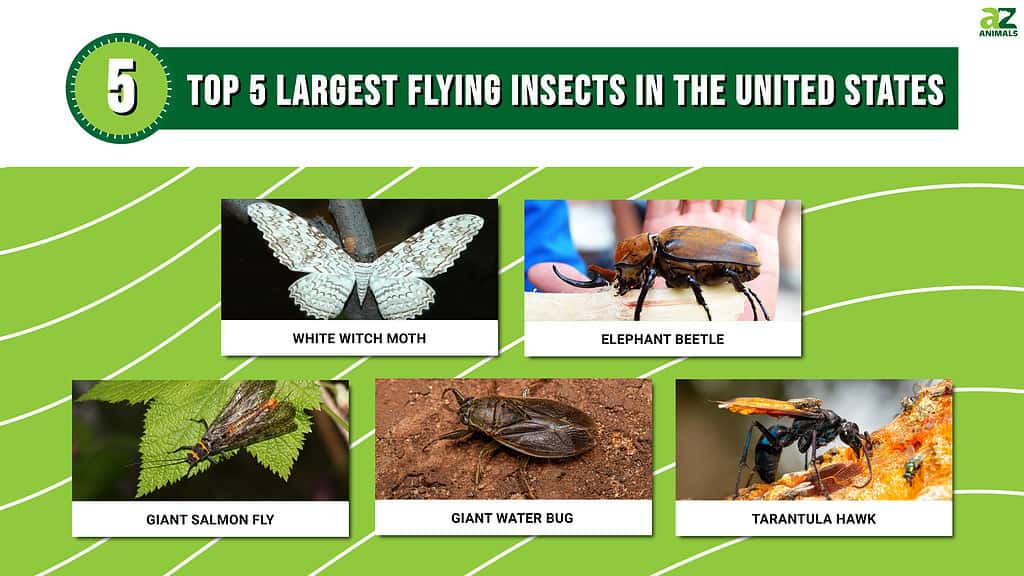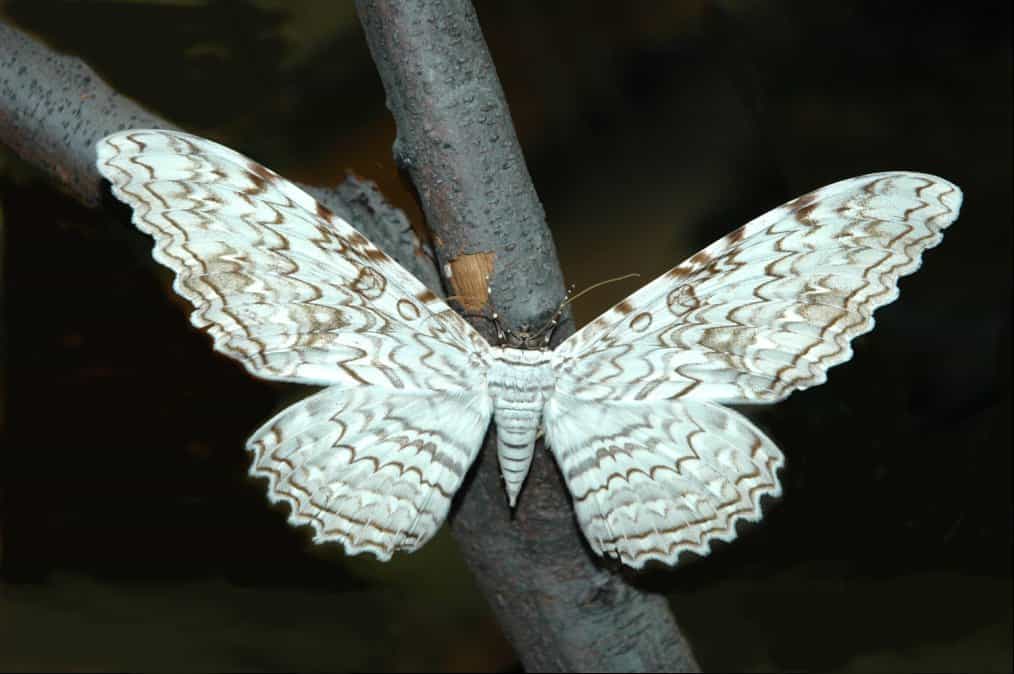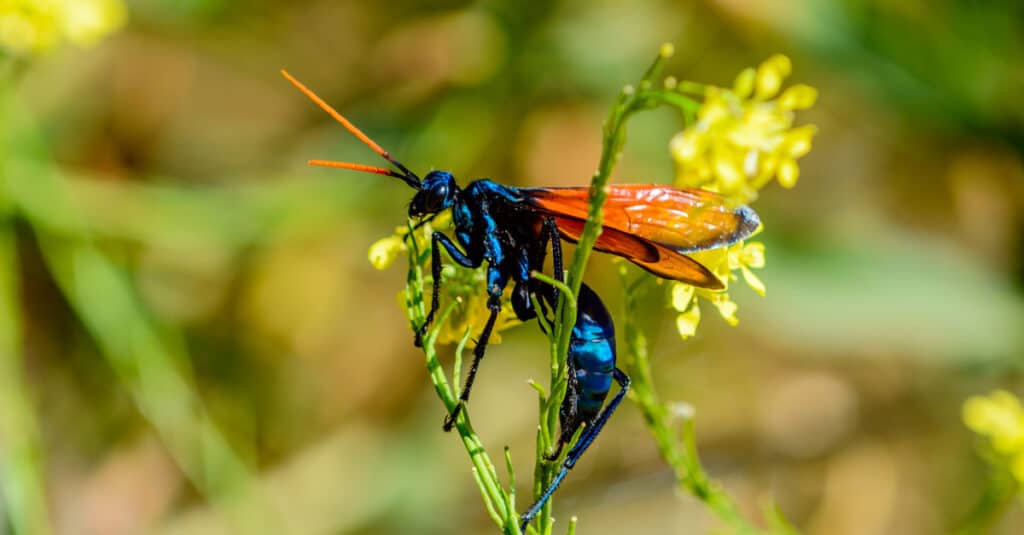There are thousands of species of insects in the United States. In fact, there are over 100,000 species of bugs in America, and among those are several giant specimens that will make your skin crawl. While these bugs are intimidating due to their size, they are harmless and best left to their own devices. Discover the top 5 flying insects in the United States and where they occur.

1. White Witch Moth
The white witch month stands out for its immense size and breathtaking beauty. They are nocturnal and occur in Central and South America. However, they also venture as far north as Texas in the United States. These gigantic moths have a wingspan of 12 to 14 inches, making them the largest flying insect in the United States and one of the biggest moths in the world. But, if their size isn’t enough, they are also distinguished by their striking white coloration.
White witch moths derived their name from their resemblance to witches, and some cultures consider these moths symbols of good luck. They are attracted to light, so people often see them fluttering around porch lights or street lamps at night. Sadly, white witch moths are rare, and their populations worldwide are dwindling. These massive moths live in various habitats, including open grasslands, rainforests, temperate forests, suburban and rural areas, and sometimes even cities. Unfortunately, entomologists do not know much about this moth beyond facts on its native habitat and appearance. White witch moths are highly adaptable and can survive in serval habitats, which is why their range is so large.

These gigantic moths have a wingspan of 12 to 14 inches, making them the largest flying insect in the United States and one of the biggest moths in the world.
©Acrocynus / CC BY-SA 3.0 – License
2. Elephant Beetle
The elephant beetle is one of the top 5 largest flying insects in the United States. They can grow to more than five inches long and barely fit into the hand of a human palm. While their size is very impressive, they don’t live very long, only a few months. Elephant beetles inhabit different regions of the Amazonian forests, South and North America, Central America, and Australia.
Their larva spends two to three years underground, feeding on plant debris. During the final stage of their lifecycle, which lasts around five weeks, they become insects. But, after five weeks, they die. In their natural habitat, elephant beetles feed on tree sap, but in captivity, they tend to prefer tropical fruits like pineapple, longan, and lychee. Elephant beetles are primarily nocturnal. They are similar to warm-blooded animals since they can regulate their body temperature to the right level when the air temperature drops.

Elephant beetles can grow to more than five inches long and barely fit into the hand of a human palm.
©Bonita R. Cheshier/Shutterstock.com
3. Giant Salmon Fly
The giant salmon fly is one of the largest flying insects in the United States, measuring up to 3 inches long. They are also an important food source for trout. When these giant salmon flies hatch in the summer, trout and birds eat their fill, and by doing so, create some of the best fly fishing in the world. When these massive flies hatch, they attract anglers from all over the planet who support small-town businesses across the western United States.
Giant salmon flies generally occur in medium to large, cold, freestone mountain streams. During their aquatic stage, the nymphs are wingless and remain underwater for three to four years. They hide under rocks and feed on woody debris and leaves. Depending on the stream or water source they live in, full-grown nymphs emerge from late May to July. Once they emerge from the water, they shed their nymphal exoskeletons, morphing into adults with wings.
Adults’ lifespans are extremely short; they only live for around seven days on the banks of the streams, usually hiding in the cottonwoods and willows. They barely eat, if they eat at all, during this stage. Their sole purpose is to find a mate and procreate. Mating pairs find each other by drumming their abdomens to attract a mate. Once mating is done, females store the fertilized eggs in their abdomens and fly upriver. Then, females crash into the river or stream, vibrating their wings and thrashing their bodies to eject the eggs into the water. However, this odd behavior attracts predators, like trout. If the eggs avoid getting eaten, they sink and settle into a substrate, where they stay for several months. These eggs will usually hatch the following spring.

Giant salmon flies in the western USA can measure up to 3 inches long.
©Walter Siegmund / CC BY-SA 3.0 – License
4. Giant Water Bug
Giant water bugs belong to the Belostomatidae family and are large, predatory, aquatic insects. They are one of the largest flying insects in the United States because they can reach 2 to 3 inches long. However, species of giant water bugs in South America can grow to over 4 inches in length. These massive bugs live in ditches and ponds where they can lay under the surface, breathing through two abdominal appendages, acting like siphons.
Giant water bugs fly to several water sources during mating season. While en route to their next destination, they fly toward light in large numbers. As a result, they earned the nickname “electric light bugs.” These bugs have painful bites due to their strong beaks. However, they might also pinch with their forelegs.
They like to prey on aquatic insects, like:
- Small birds
- Small fish
- Frogs
- Tadpoles
- Other organisms in their environment
When they bite their prey, powerful enzymes are injected into the animal, killing it. But, these giant bugs have also become prey, as they are a delicacy in Asia, where they are eaten cooked or fresh.

Giant water bugs are one of the largest flying insects in the United States because they can reach 2 to 3 inches long.
©iStock.com/ViniSouza128
5. Tarantula Hawk
Making up the last member of the list, the tarantula hawk is a large wasp. The most common species of these wasps in the Grand Canyon is Pepsis thisbe, which grows up to 2 inches long. These massive wasps occur on every continent in the world except Antarctica and Europe. However, in the United States, they primarily occur on the South Rim and inside the Grand Canyon where they can prey on tarantulas.
Male tarantula hawks feed on nectar from flowers, but the females are a bit more brutal. They hunt tarantulas for food and a safe place to keep their eggs. For example, tarantula hawks use their stingers to paralyze tarantulas. Once the tarantula is immobile, the wasp transports the spider back to its nest. She then lays her eggs on the spider’s abdomen and traps it inside the burrow by covering the entrance. When the eggs hatch, the larvae feed off the living tarantula for a few weeks and purposely avoid vital organs to keep it alive until the larvae are old enough to pupate into an adult wasp.
While females have a ¼ inch stinger, males have none, so they are harmless. But, if a female stings you, it is extremely painful. Luckily, they won’t sting you unless you provoke them. The only predator that will risk getting stung by a tarantula hawk is the roadrunner, who enjoys feeding on these giant wasps.

These massive wasps occur on every continent in the world except Antarctica and Europe. However, in the United States, they primarily occur on the South Rim and inside the Grand Canyon.
©Robert Briggs/Shutterstock.com
Summary of the Largest Flying Insects in the United States
| Flying Insect | Size |
|---|---|
| White Witch Moth | 12 inches |
| Elephant Beetle | 5 inches |
| Giant Salmon Fly | 3 inches |
| Giant Water Bug | 2 to 3 inches |
| Tarantula Hawk | 2 inches |
The photo featured at the top of this post is © Acrocynus / CC BY-SA 3.0 – License / Original
Thank you for reading! Have some feedback for us? Contact the AZ Animals editorial team.







